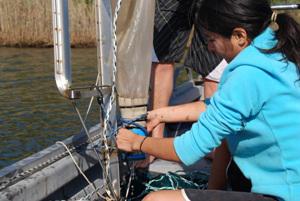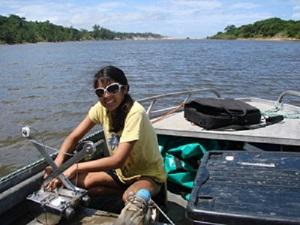Kelly Ortega Cisneros
The aim of the project is to determine the ecosystem functioning of selected estuaries in KwaZulu-Natal and represent their dynamics through ecosystem models to predict various scenarios for environmental threats.

Sampling of zooplankton at Mlalazi estuary during September 2010. ©Troy Inman
One of the main threats to estuaries in KwaZulu-Natal (KZN), South Africa is habitat degradation through freshwater abstraction from catchments, pollution and land use changes. This can result in degraded water quality, habitat loss and less frequent inlet openings and exchange with the adjacent marine environment. The latter can cause significant negative effects on estuarine biota and recreationally/ commercially exploited fish and invertebrate stocks.

Sampling with van Veen grab at Mlalazi estuary during February 2011. © Troy Inman.
Temporarily open/ closed estuary (TOCE) accounts for more than 70% of estuaries in South Africa. Contrarily, permanently open estuaries (POE) are very scarce with only three recorded in KZN. The scarceness of predominantly open estuaries in KZN therefore increases the value of the habitat they provide to estuarine dependent species. In KZN, estuaries are highly dynamic and undergo dramatic changes in their outflow and mouth status (open/closed) due to strong seasonal patterns in rainfall and freshwater run-off. The consequences of freshwater starvation depend on the estuary type and its locality. It is thus fundamental to determine the functioning of these estuary types (permanently open and temporarily open/closed estuary) in terms of biomass, habitat supply to the species depending on it and connections with adjacent environments to understand their ecology, services and predict their responses to different environmental threats.
Four field trips will be conducted to both the Mlalazi (POE) and Mpenjati (TOCE) estuaries in KwaZulu-Natal. Biological and environmental samples will be taken along the estuary and in particular at the estuary mouth to quantify inputs and outputs to/from the estuary. In each station, planktonic, benthic and fish samples will be collected. Stable isotope analysis will be conducted to evaluate changes in carbon and nitrogen isotopes through space and time and quantify the carbon and nitrogen pools within the estuaries. These biological and isotopic data will be used to build models of these two types of estuaries through Ecological Network analysis.
Ecosystem models outputs will provide an insight of the ecosystem functioning of these estuaries and be calibrated against available time-series data produced for this study. This study will also determine possible scenarios for each type of estuary and predict the response of each trophic group to changes in abiotic drivers such as water level, mouth status and availability of nutrients. Finally, this work will constitute a framework for future comparison and management of estuaries in the country.